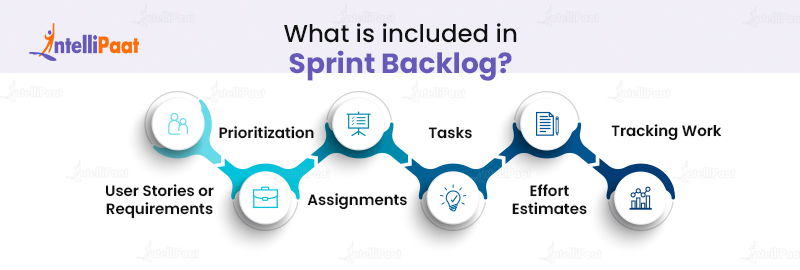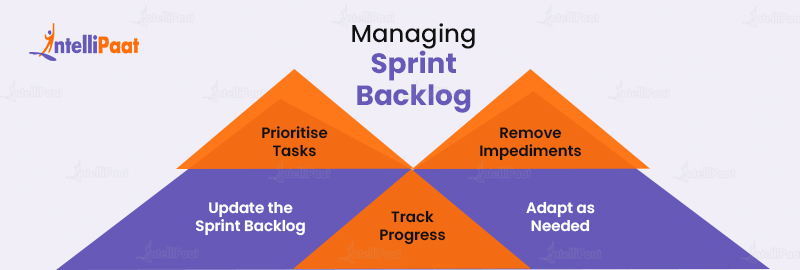What Is Sprint Backlog?
The sprint backlog is essential in Agile project management, from task prioritization to progress monitoring. To understand it in a better way, let us discuss it in more depth.
- What is Sprint Backlog?
- What is Included in Sprint Backlog?
- Difference between Sprint Backlog and Product Backlog
- Managing Sprint Backlog
- Conclusion
To excel in the field of Agile, watch our video on the Agile project management course.
{
“@context”: “https://schema.org”,
“@type”: “VideoObject”,
“name”: “Agile Project Management Full Course | Agile Course | Agile Training | Intellipaat”,
“description”: “What Is Sprint Backlog?”,
“thumbnailUrl”: “https://img.youtube.com/vi/tlB-WAR0j-U/hqdefault.jpg”,
“uploadDate”: “2023-05-18T08:00:00+08:00”,
“publisher”: {
“@type”: “Organization”,
“name”: “Intellipaat Software Solutions Pvt Ltd”,
“logo”: {
“@type”: “ImageObject”,
“url”: “https://intellipaat.com/blog/wp-content/themes/intellipaat-blog-new/images/logo.png”,
“width”: 124,
“height”: 43
}
},
“contentUrl”: “https://www.youtube.com/watch?v=tlB-WAR0j-U”,
“embedUrl”: “https://www.youtube.com/embed/tlB-WAR0j-U”
}
What is Sprint Backlog?
A sprint is a restricted period, generally 2-4 weeks, during which a team of developers works to finish a specific set of tasks. At the end of the sprint, the objective is to have a functional increment of software.
A Sprint Backlog is a list of work that a team of developers intends to perform over a specified period is known as a Sprint. A Sprint usually lasts two to four weeks, during which time the team works to finish a certain set of tasks.
The Sprint Backlog in Agile methodology is produced during the Sprint Planning meeting, where the team picks the items from the Product Backlog that they will work on during the Sprint. The Product Backlog is a prioritized list of features, enhancements, and bug fixes that the team must achieve within the project’s duration.
The Sprint Backlog is a dynamic document that is updated throughout the Sprint. It is used by the team to track their progress, make modifications, and ensure that they are on pace to finish the task inside the Sprint.
Each item on the Sprint Backlog should be split down into smaller tasks so that the team may work on them in a more manageable manner. These tasks should be short enough to be done in a day or two and assigned to individual team members.
Enroll in our Agile Training to gain certification in this field and earn a rewarding profession.
What is included in Sprint Backlog?

Sprint Backlog contains the following information:
User Stories or Requirements
These are high-level descriptions of what end-users or customers want the product to perform. The team will divide these tales into distinct tasks that must be done.
Tasks
These are the precise activities or work items that must be accomplished to meet a user narrative or requirement. Tasks should be well-defined, modest enough to be done in a single day, and not dependent on other tasks. A task may be “create a login screen” or “write unit tests for feature X”.
Effort Estimates
Each job should have an effort estimate, which is a measure of how much effort is necessary to execute the activity. The team may estimate the effort necessary using several approaches, such as T-Shirt sizing.
Prioritization
The things in the Sprint Backlog should be prioritized by the team, with the most important items at the top of the list. This allows the team to focus on the most important tasks and provide value to the client as soon as feasible.
Assignments
Each work should be given to a different member of the team. This ensures that everyone understands what they are accountable for and helps to avoid duplication of work.
Tracking work
The Sprint Backlog is a dynamic document that is updated during the Sprint to reflect the work of the team. Team members report on their progress and any challenges they are encountering at the Daily Scrum meeting, and the Sprint Backlog has changed accordingly.
Difference between Sprint Backlog and Product Backlog
Here are the key difference between Sprint Backlog and Product Backlog:
| Basis | Sprint Backlog | Product Backlog |
| Definition | A list of tasks to be completed during a sprint. | A prioritized list of user stories that need to be developed for the product. |
| Timeframe | One sprint, typically 2-4 weeks. | The entire project lifecycle. |
| Owner | Owned by the development team. | Owned by the Product Owner. |
| Updates | Can be updated by the development team during the sprint. | Can be updated by the Product Owner at any time. |
| Purpose | To plan and track progress during a sprint. | To provide a high-level view of the work to be done over the course of the project. |
| Content | Contains a subset of user stories from the Product Backlog that the team commits to completing during the sprint. | Contains all the user stories that need to be developed for the product, including those not yet planned for a sprint. |
You can refer to Intellipaat’s Top Agile Scrum Master Interview Questions and Answers for better insights.
Managing Sprint Backlog

Managing a Sprint Backlog entails numerous processes, and here are some general principles for doing so effectively:
Update the Sprint Backlog
The team should update the Sprint Backlog on a regular basis to reflect the current progress of the task. This involves adding new jobs, deleting finished tasks, and changing estimates as appropriate.
Prioritise Tasks
The team should constantly prioritize tasks based on their significance and interdependence. This ensures that the most important activities are accomplished first and that progress towards the Sprint Goal is made. A Sprint goal is a concise statement that describes what the team plans to accomplish during the sprint.
Career Transition
Track Progress
The team should track progress toward the Sprint Goal by reviewing the Sprint Backlog on a regular basis at the Daily Scrum. This allows the team to detect any problems or barriers early on and take appropriate action.
Remove impediments
The team should endeavor to remove any impediments that are impeding progress toward the Sprint Goal. Working with stakeholders or other teams to address issues or escalate problems as needed.
Adapt as Needed
The team should be willing to make modifications to the Sprint Backlog when they learn more about the work to be done or find new information or barriers. This helps to ensure that the team stays adaptable and may change direction as needed to reach the Sprint Goal.
Conclusion
Finally, the Sprint Backlog is a vital tool for Agile teams, assisting them in planning and managing their work during the Sprint. As Agile development evolves, the Sprint Backlog is expected to become increasingly essential, with new approaches and technologies emerging to support its use. Teams may enhance their productivity, quality, and customer satisfaction by adhering to best practices for building and managing a Sprint Backlog, resulting in more successful software development projects.
In case of any doubts, you can ask them on our Community Page.
The post What Is Sprint Backlog? appeared first on Intellipaat Blog.
Blog: Intellipaat - Blog
Leave a Comment
You must be logged in to post a comment.













